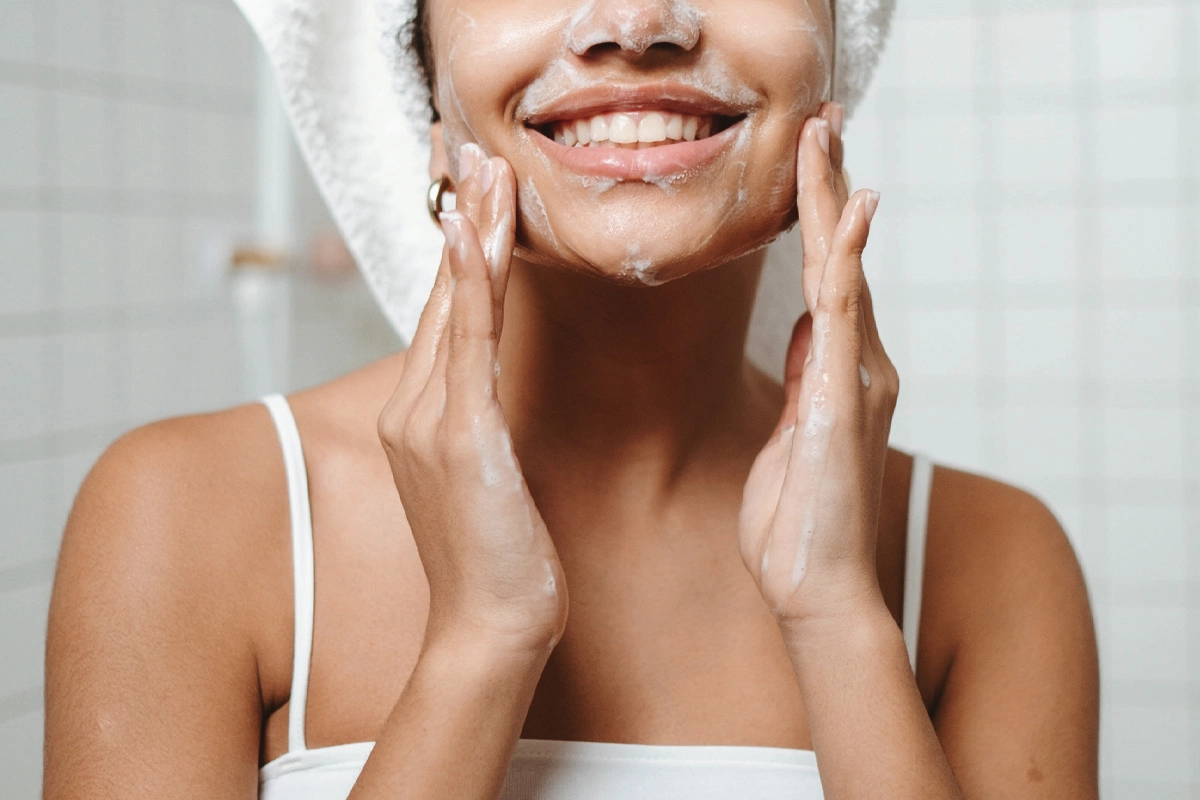Table of Contents[Hide][Show]
Cleansing your face feels like it should be simple, yet it’s a step shrouded in a surprising amount of uncertainty. We stand at the sink, going through the motions, but a quiet question often lingers: Am I rushing this? Could I be leaving it on for too long? Most of us are simply guessing, unsure if this foundational act is truly serving our skin in the best way possible.
So, what is the definitive, science-backed timeframe for a truly effective cleanse? And more importantly, what is actually happening on your skin during those moments that makes such a profound difference to its long-term health and radiance?
This guide will settle the debate once and for all. We’ll reveal the esthetician-approved “sweet spot” for cleansing time and explain the beautiful science of why this specific duration transforms a simple wash into a powerful, calming ritual for your skin.
The Esthetician’s Verdict: The 60-Second Rule

The answer is surprisingly simple and incredibly effective: for most people and most cleansers, the ideal amount of time to massage a cleanser into your face is a full 60 seconds. This isn’t an arbitrary number; it’s the intersection of scientific efficacy and mindful self-care. To understand its power, let’s break down the beautiful science of that single minute.
Why Less Than 60 Seconds is an Incomplete Cleanse
A quick 15-second wash is like skimming the surface of a pool instead of truly diving in. It simply doesn’t give your cleanser’s ingredients (called surfactants) nearly enough time to do their job properly. Think of everything on your skin: an oily layer of sunscreen, a face of worn makeup from the day, environmental pollutants, and hardened sebum. These complex layers need time to be softened and dissolved. A rushed wash often leaves a microscopic film of residue behind, which not only hinders the absorption of your precious serums that follow but can also contribute to dullness and congestion over time.
Why More Than 60 Seconds Can Compromise Your Barrier
On the other end of the spectrum, it’s crucial to understand that a cleanser is meant to be worked into the skin. Its surfactants are specifically designed to bind to oil and impurities so they can be rinsed away. When left on the skin for too long (say, several minutes), these surfactants found in common cleansers can continue their work indiscriminately. They can begin to disrupt the essential, protective lipids that form your skin’s delicate barrier. This is what leads to that uncomfortable, stripped, and tight feeling, and it can trigger a frustrating cycle of irritation and dehydration.
That said, a gentle, pH-balanced cleanser is formulated differently. Rather than harsh surfactants that over-cleanse, it uses milder cleansing agents and nourishing botanicals that support—not strip—the skin. These formulas help maintain harmony in the skin’s microbiome and moisture barrier, so even if your cleansing ritual takes a little longer, the ingredients work to soothe and replenish rather than break down what your skin needs to stay balanced and resilient.
The 60-Second “Sweet Spot”: The Science of a Perfect Cleanse
One full minute is the therapeutic window where everything a cleanse is meant to do happens in perfect harmony.
- Effective Purification: It allows the cleanser’s ingredients to fully soften and dissolve impurities without beginning to compromise the skin’s own protective oils.
- Mindful Massage: It gently forces you to slow down, transforming a functional step into a mindful facial massage. This simple act boosts circulation and encourages lymphatic drainage, which promotes that natural, healthy-looking glow from within.
- Enhanced Connection: This single minute is a daily opportunity to truly feel your skin—to notice its texture, to be present with its needs, and to turn a routine chore into a genuine moment of connection and self-care.
Does the 60-Second Rule Change for Different Cleanser Types?

While the 60-second rule is a fantastic universal guideline, the experience and benefits of that minute can feel beautifully different depending on the texture of your chosen cleanser. Here’s how to embrace the ritual for these common types.
For Cream & Gel Cleansers
For these textures, the 60-second rule is the absolute gold standard. It allows gentle, often herb-infused formulas to offer their full purifying and soothing benefits without ever stripping the skin. During this soothing minute, you’ll truly get to appreciate the sensory experience of your cleanser. You might feel a cream cleanser transform, providing a cushioned, nourishing glide, or a gel cleanser offering a refreshing, awakening slip that makes the ritual a true pleasure.
For Oil Cleansers (The First Step of a Double Cleanse)
As the foundational first step in the double cleansing method, the 60-second massage is absolutely essential for an oil cleanser. It is during this full minute that the scientific principle of “like dissolves like” truly comes to life. You need this time to allow the cleanser’s oils to fully bind with and melt away the day’s oil-based impurities, like makeup and sunscreen. You can often literally feel the texture on your skin change as stubborn impurities break down. Furthermore, this minute-long massage provides the perfect, elegant slip for a more intentional, tension-releasing ritual. Using an oil cleanser makes it an ideal opportunity to incorporate a Gua Sha tool early on in your routine, which can transform this simple step into a truly luxurious experience. Otherwise, you can incorporate it after you cleanse, tone, and apply serum—you’ll just want to make sure you choose a facial oil best suited for a Gua Sha massage.
From a Chore to a Cherished Ritual
The key takeaway from all of this is simple, yet profoundly transformative: cleansing your skin for a full 60 seconds is one of the easiest and most impactful changes you can make to your entire skin care routine. It elevates a rushed, thoughtless chore into a powerful, calming ritual that honors your skin.
We encourage you to try the 60-second rule for just one week. That’s it. Pay close attention to the shift in your skin—notice how much softer, cleaner, and more balanced it feels. Notice how your serums seem to absorb more readily. Most importantly, notice how it feels to dedicate a single, intentional minute to yourself each morning and night.
After your 60-second ritual, your skin feels soft, balanced, and perfectly prepped to receive the nourishment that follows. This is the perfect moment to apply your serums and then seal in that beautiful work with a final moisturizing layer. If your skin craves a creamy, comforting finish, a nourishing cream like our Restorative Facial Cream is a beautiful choice. Or, if you love the targeted nourishment and radiant glow of a facial oil, the Anti-Aging Facial Oil is wonderful for mature skin, while the Rejuvenating Facial Oil helps restore a feeling of harmony. Finding the perfect final layer for your routine is a beautiful journey, and you can explore all of our Facial Oils to find your perfect match.
Frequently Asked Questions
What if I have very sensitive skin? Is 60 seconds too long?
For very sensitive or reactive skin, the gentleness of your cleanser is far more important than the exact time. You can absolutely still aim for 60 seconds, but use extremely light, feather-like pressure. If your skin feels uncomfortable at any point, it’s likely a sign that your cleanser may be too harsh for you, not that the duration is wrong.
Should I do this for both my morning and evening cleanse?
Yes, the 60-second rule is beneficial for both. In the evening, it’s essential for thoroughly removing the day’s full buildup of makeup, sunscreen, and pollutants. In the morning, it helps to invigorate the skin, boost the look of circulation, and create a perfectly clean and balanced canvas for your daytime products.
What is the next step I should take right after cleansing?
After you pat your skin dry, mist the skin with a toning mist to prepare it to become the perfect state to receive your most potent, targeted treatments, like serums, followed by a facial oil. This leads to another common question, which you can explore in our guide on the key differences between a facial oil and a serum.







Leave a Reply